Career Episode 1: Construction of a New Building
VerifiedAdded on 2023/04/21
|8
|2334
|381
AI Summary
This career episode describes the experience of a structural design engineer in constructing a new building after removing an existing establishment. It covers the responsibilities, challenges, and solutions faced during the project.
Contribute Materials
Your contribution can guide someone’s learning journey. Share your
documents today.
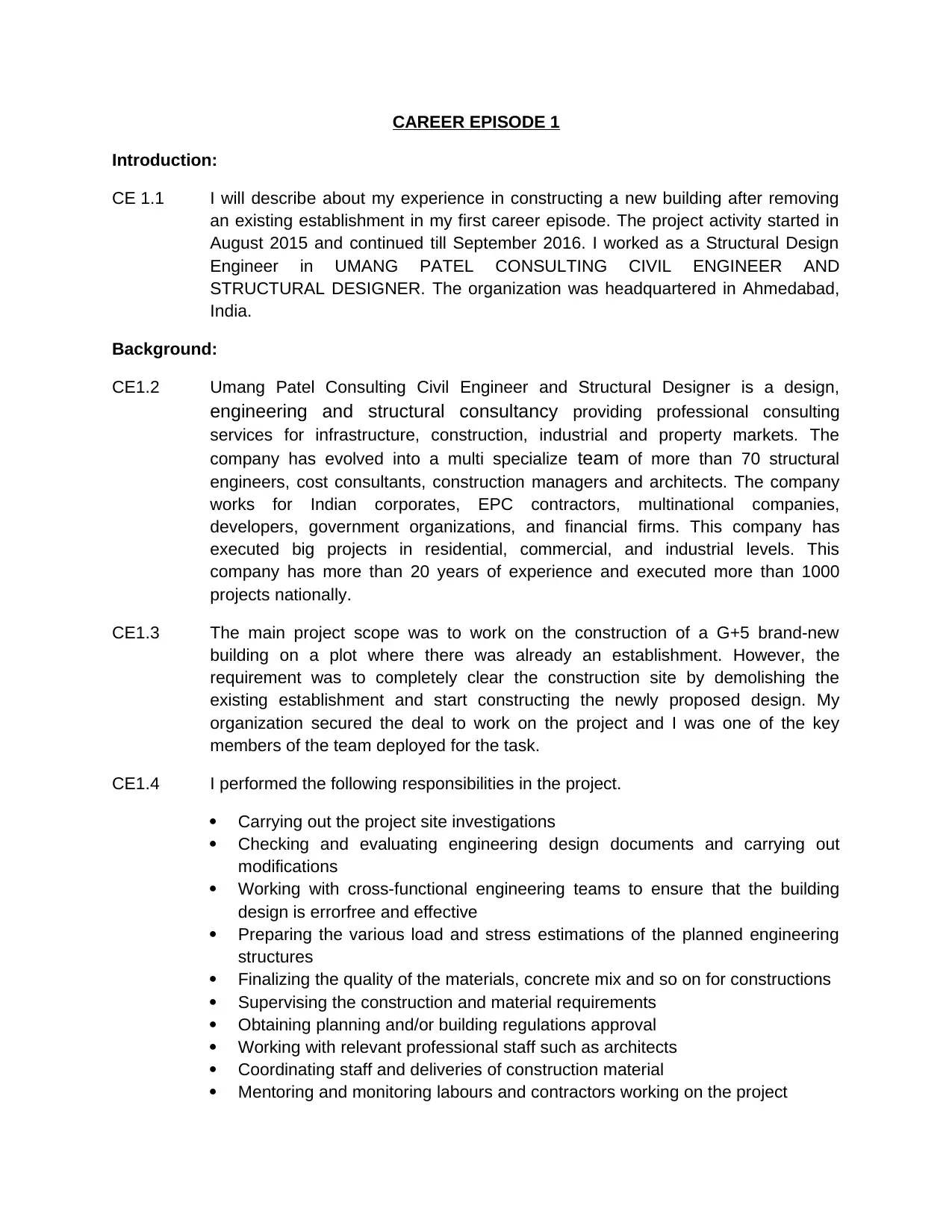
CAREER EPISODE 1
Introduction:
CE 1.1 I will describe about my experience in constructing a new building after removing
an existing establishment in my first career episode. The project activity started in
August 2015 and continued till September 2016. I worked as a Structural Design
Engineer in UMANG PATEL CONSULTING CIVIL ENGINEER AND
STRUCTURAL DESIGNER. The organization was headquartered in Ahmedabad,
India.
Background:
CE1.2 Umang Patel Consulting Civil Engineer and Structural Designer is a design,
engineering and structural consultancy providing professional consulting
services for infrastructure, construction, industrial and property markets. The
company has evolved into a multi specialize team of more than 70 structural
engineers, cost consultants, construction managers and architects. The company
works for Indian corporates, EPC contractors, multinational companies,
developers, government organizations, and financial firms. This company has
executed big projects in residential, commercial, and industrial levels. This
company has more than 20 years of experience and executed more than 1000
projects nationally.
CE1.3 The main project scope was to work on the construction of a G+5 brand-new
building on a plot where there was already an establishment. However, the
requirement was to completely clear the construction site by demolishing the
existing establishment and start constructing the newly proposed design. My
organization secured the deal to work on the project and I was one of the key
members of the team deployed for the task.
CE1.4 I performed the following responsibilities in the project.
Carrying out the project site investigations
Checking and evaluating engineering design documents and carrying out
modifications
Working with cross-functional engineering teams to ensure that the building
design is errorfree and effective
Preparing the various load and stress estimations of the planned engineering
structures
Finalizing the quality of the materials, concrete mix and so on for constructions
Supervising the construction and material requirements
Obtaining planning and/or building regulations approval
Working with relevant professional staff such as architects
Coordinating staff and deliveries of construction material
Mentoring and monitoring labours and contractors working on the project
Introduction:
CE 1.1 I will describe about my experience in constructing a new building after removing
an existing establishment in my first career episode. The project activity started in
August 2015 and continued till September 2016. I worked as a Structural Design
Engineer in UMANG PATEL CONSULTING CIVIL ENGINEER AND
STRUCTURAL DESIGNER. The organization was headquartered in Ahmedabad,
India.
Background:
CE1.2 Umang Patel Consulting Civil Engineer and Structural Designer is a design,
engineering and structural consultancy providing professional consulting
services for infrastructure, construction, industrial and property markets. The
company has evolved into a multi specialize team of more than 70 structural
engineers, cost consultants, construction managers and architects. The company
works for Indian corporates, EPC contractors, multinational companies,
developers, government organizations, and financial firms. This company has
executed big projects in residential, commercial, and industrial levels. This
company has more than 20 years of experience and executed more than 1000
projects nationally.
CE1.3 The main project scope was to work on the construction of a G+5 brand-new
building on a plot where there was already an establishment. However, the
requirement was to completely clear the construction site by demolishing the
existing establishment and start constructing the newly proposed design. My
organization secured the deal to work on the project and I was one of the key
members of the team deployed for the task.
CE1.4 I performed the following responsibilities in the project.
Carrying out the project site investigations
Checking and evaluating engineering design documents and carrying out
modifications
Working with cross-functional engineering teams to ensure that the building
design is errorfree and effective
Preparing the various load and stress estimations of the planned engineering
structures
Finalizing the quality of the materials, concrete mix and so on for constructions
Supervising the construction and material requirements
Obtaining planning and/or building regulations approval
Working with relevant professional staff such as architects
Coordinating staff and deliveries of construction material
Mentoring and monitoring labours and contractors working on the project
Secure Best Marks with AI Grader
Need help grading? Try our AI Grader for instant feedback on your assignments.
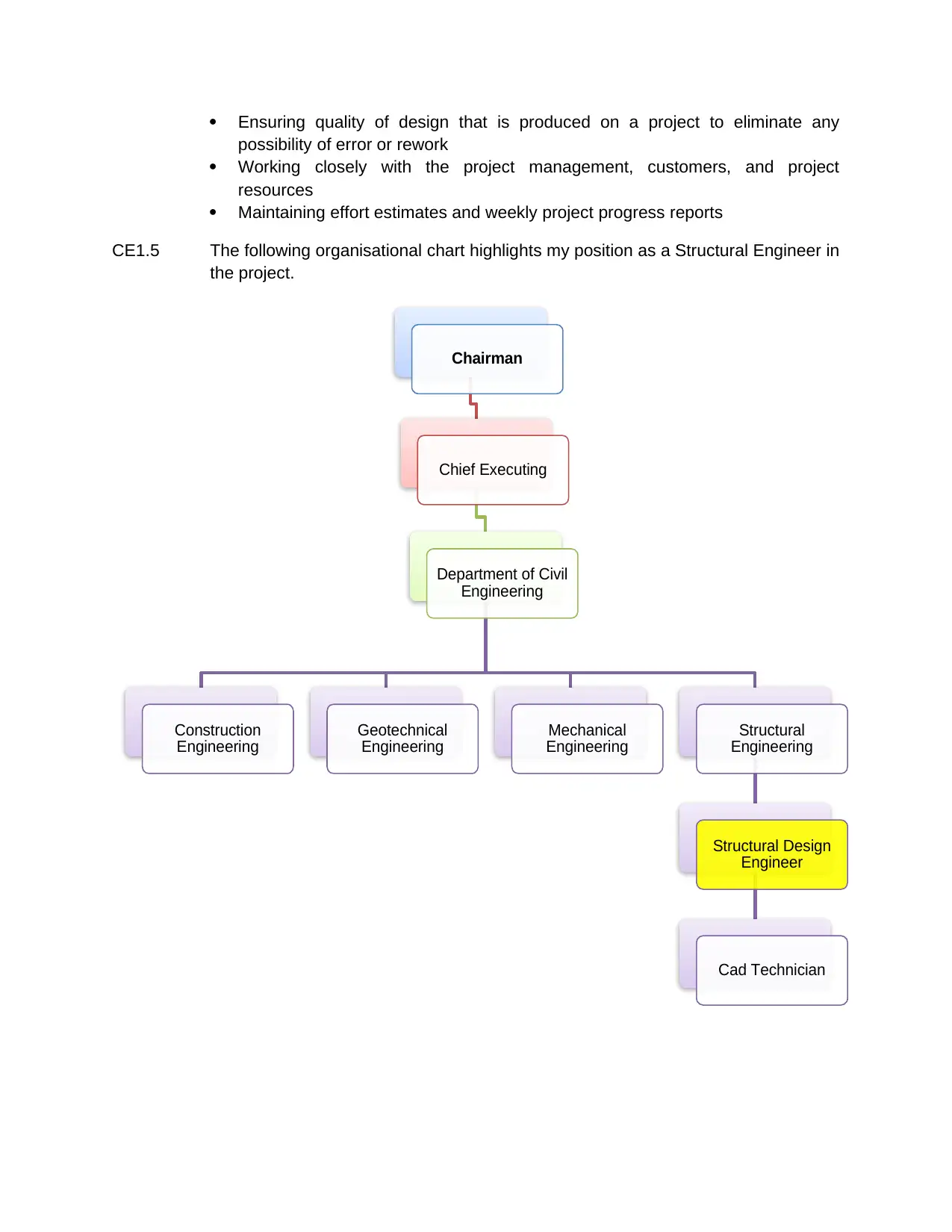
Ensuring quality of design that is produced on a project to eliminate any
possibility of error or rework
Working closely with the project management, customers, and project
resources
Maintaining effort estimates and weekly project progress reports
CE1.5 The following organisational chart highlights my position as a Structural Engineer in
the project.
Chairman
Chief Executing
Department of Civil
Engineering
Construction
Engineering
Geotechnical
Engineering
Mechanical
Engineering
Structural
Engineering
Structural Design
Engineer
Cad Technician
possibility of error or rework
Working closely with the project management, customers, and project
resources
Maintaining effort estimates and weekly project progress reports
CE1.5 The following organisational chart highlights my position as a Structural Engineer in
the project.
Chairman
Chief Executing
Department of Civil
Engineering
Construction
Engineering
Geotechnical
Engineering
Mechanical
Engineering
Structural
Engineering
Structural Design
Engineer
Cad Technician
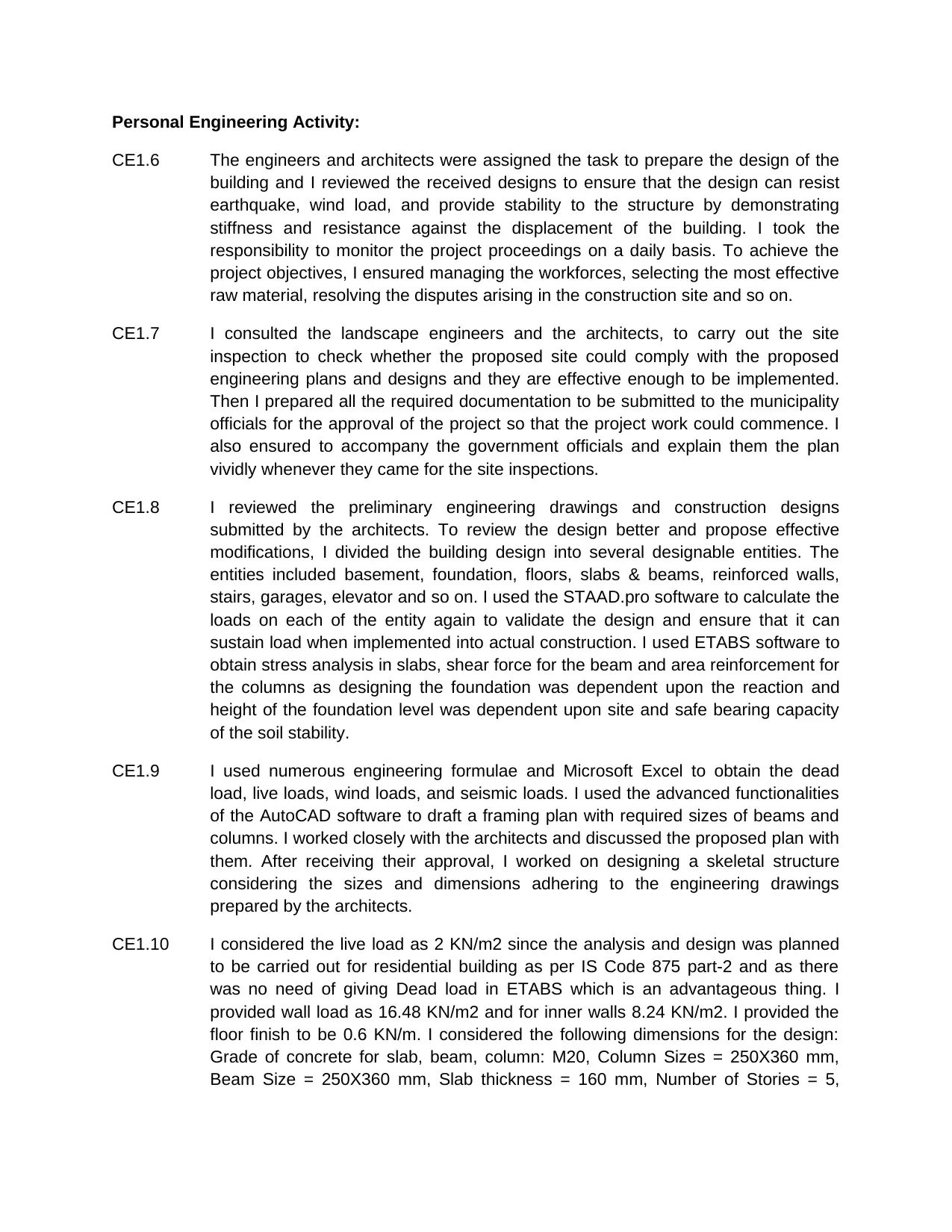
Personal Engineering Activity:
CE1.6 The engineers and architects were assigned the task to prepare the design of the
building and I reviewed the received designs to ensure that the design can resist
earthquake, wind load, and provide stability to the structure by demonstrating
stiffness and resistance against the displacement of the building. I took the
responsibility to monitor the project proceedings on a daily basis. To achieve the
project objectives, I ensured managing the workforces, selecting the most effective
raw material, resolving the disputes arising in the construction site and so on.
CE1.7 I consulted the landscape engineers and the architects, to carry out the site
inspection to check whether the proposed site could comply with the proposed
engineering plans and designs and they are effective enough to be implemented.
Then I prepared all the required documentation to be submitted to the municipality
officials for the approval of the project so that the project work could commence. I
also ensured to accompany the government officials and explain them the plan
vividly whenever they came for the site inspections.
CE1.8 I reviewed the preliminary engineering drawings and construction designs
submitted by the architects. To review the design better and propose effective
modifications, I divided the building design into several designable entities. The
entities included basement, foundation, floors, slabs & beams, reinforced walls,
stairs, garages, elevator and so on. I used the STAAD.pro software to calculate the
loads on each of the entity again to validate the design and ensure that it can
sustain load when implemented into actual construction. I used ETABS software to
obtain stress analysis in slabs, shear force for the beam and area reinforcement for
the columns as designing the foundation was dependent upon the reaction and
height of the foundation level was dependent upon site and safe bearing capacity
of the soil stability.
CE1.9 I used numerous engineering formulae and Microsoft Excel to obtain the dead
load, live loads, wind loads, and seismic loads. I used the advanced functionalities
of the AutoCAD software to draft a framing plan with required sizes of beams and
columns. I worked closely with the architects and discussed the proposed plan with
them. After receiving their approval, I worked on designing a skeletal structure
considering the sizes and dimensions adhering to the engineering drawings
prepared by the architects.
CE1.10 I considered the live load as 2 KN/m2 since the analysis and design was planned
to be carried out for residential building as per IS Code 875 part-2 and as there
was no need of giving Dead load in ETABS which is an advantageous thing. I
provided wall load as 16.48 KN/m2 and for inner walls 8.24 KN/m2. I provided the
floor finish to be 0.6 KN/m. I considered the following dimensions for the design:
Grade of concrete for slab, beam, column: M20, Column Sizes = 250X360 mm,
Beam Size = 250X360 mm, Slab thickness = 160 mm, Number of Stories = 5,
CE1.6 The engineers and architects were assigned the task to prepare the design of the
building and I reviewed the received designs to ensure that the design can resist
earthquake, wind load, and provide stability to the structure by demonstrating
stiffness and resistance against the displacement of the building. I took the
responsibility to monitor the project proceedings on a daily basis. To achieve the
project objectives, I ensured managing the workforces, selecting the most effective
raw material, resolving the disputes arising in the construction site and so on.
CE1.7 I consulted the landscape engineers and the architects, to carry out the site
inspection to check whether the proposed site could comply with the proposed
engineering plans and designs and they are effective enough to be implemented.
Then I prepared all the required documentation to be submitted to the municipality
officials for the approval of the project so that the project work could commence. I
also ensured to accompany the government officials and explain them the plan
vividly whenever they came for the site inspections.
CE1.8 I reviewed the preliminary engineering drawings and construction designs
submitted by the architects. To review the design better and propose effective
modifications, I divided the building design into several designable entities. The
entities included basement, foundation, floors, slabs & beams, reinforced walls,
stairs, garages, elevator and so on. I used the STAAD.pro software to calculate the
loads on each of the entity again to validate the design and ensure that it can
sustain load when implemented into actual construction. I used ETABS software to
obtain stress analysis in slabs, shear force for the beam and area reinforcement for
the columns as designing the foundation was dependent upon the reaction and
height of the foundation level was dependent upon site and safe bearing capacity
of the soil stability.
CE1.9 I used numerous engineering formulae and Microsoft Excel to obtain the dead
load, live loads, wind loads, and seismic loads. I used the advanced functionalities
of the AutoCAD software to draft a framing plan with required sizes of beams and
columns. I worked closely with the architects and discussed the proposed plan with
them. After receiving their approval, I worked on designing a skeletal structure
considering the sizes and dimensions adhering to the engineering drawings
prepared by the architects.
CE1.10 I considered the live load as 2 KN/m2 since the analysis and design was planned
to be carried out for residential building as per IS Code 875 part-2 and as there
was no need of giving Dead load in ETABS which is an advantageous thing. I
provided wall load as 16.48 KN/m2 and for inner walls 8.24 KN/m2. I provided the
floor finish to be 0.6 KN/m. I considered the following dimensions for the design:
Grade of concrete for slab, beam, column: M20, Column Sizes = 250X360 mm,
Beam Size = 250X360 mm, Slab thickness = 160 mm, Number of Stories = 5,
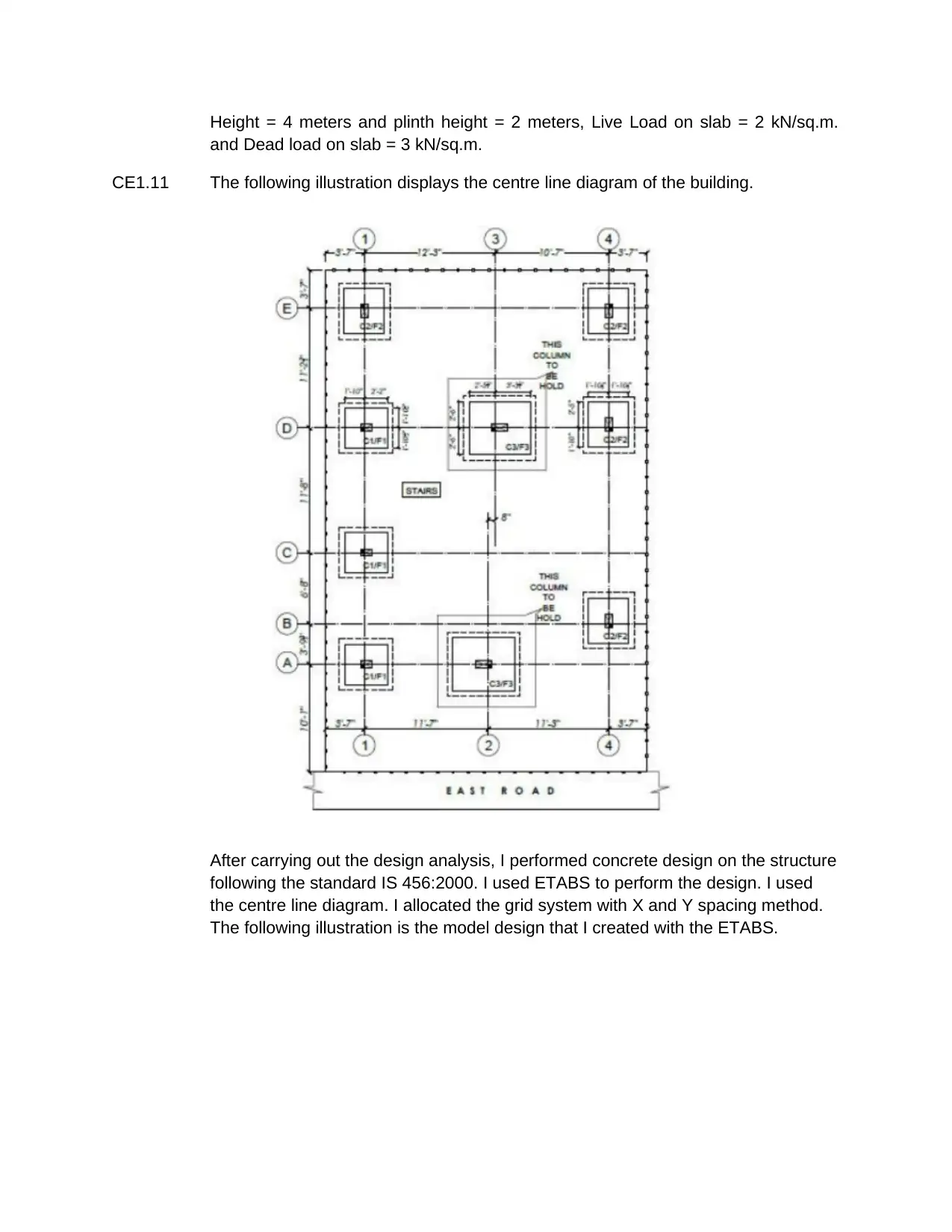
Height = 4 meters and plinth height = 2 meters, Live Load on slab = 2 kN/sq.m.
and Dead load on slab = 3 kN/sq.m.
CE1.11 The following illustration displays the centre line diagram of the building.
After carrying out the design analysis, I performed concrete design on the structure
following the standard IS 456:2000. I used ETABS to perform the design. I used
the centre line diagram. I allocated the grid system with X and Y spacing method.
The following illustration is the model design that I created with the ETABS.
and Dead load on slab = 3 kN/sq.m.
CE1.11 The following illustration displays the centre line diagram of the building.
After carrying out the design analysis, I performed concrete design on the structure
following the standard IS 456:2000. I used ETABS to perform the design. I used
the centre line diagram. I allocated the grid system with X and Y spacing method.
The following illustration is the model design that I created with the ETABS.
Secure Best Marks with AI Grader
Need help grading? Try our AI Grader for instant feedback on your assignments.
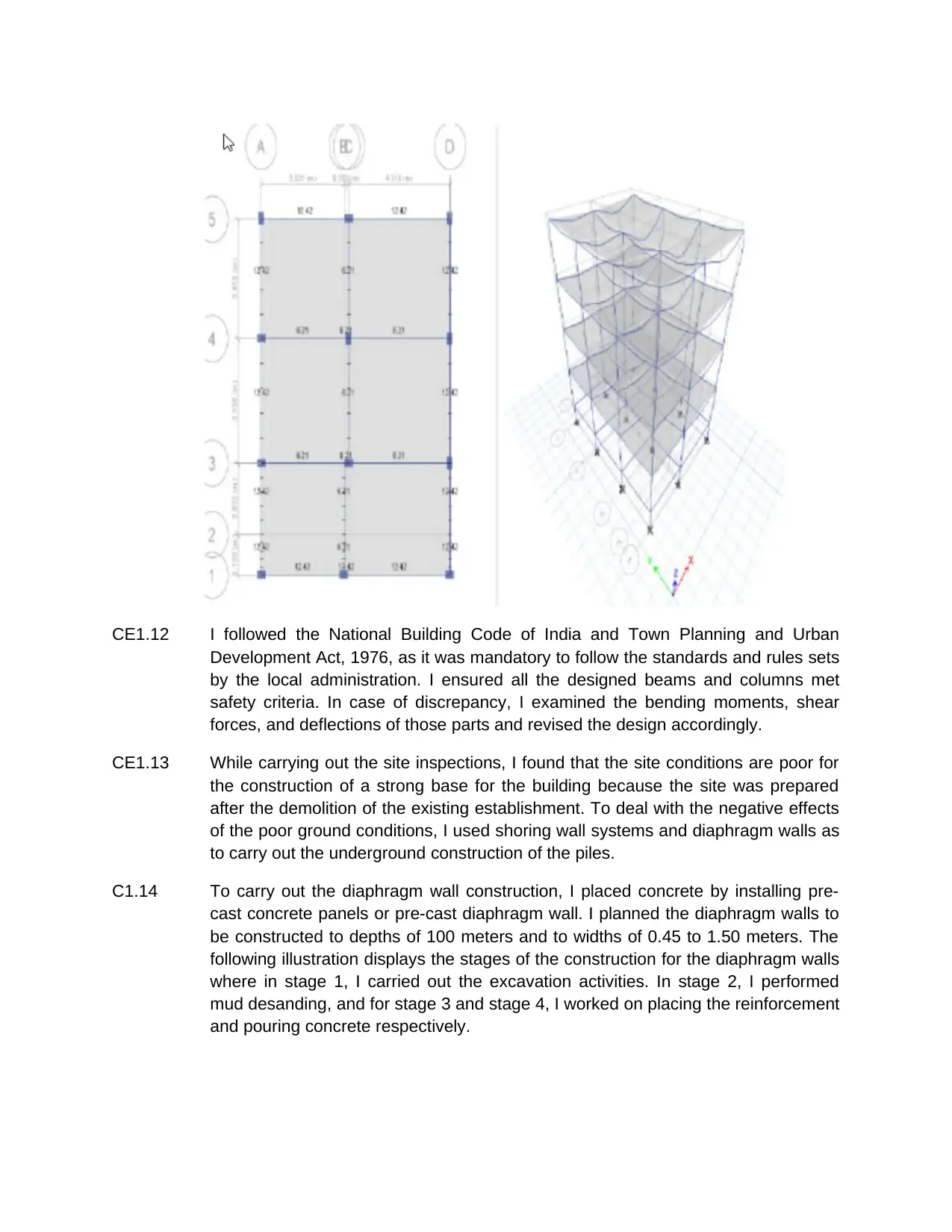
CE1.12 I followed the National Building Code of India and Town Planning and Urban
Development Act, 1976, as it was mandatory to follow the standards and rules sets
by the local administration. I ensured all the designed beams and columns met
safety criteria. In case of discrepancy, I examined the bending moments, shear
forces, and deflections of those parts and revised the design accordingly.
CE1.13 While carrying out the site inspections, I found that the site conditions are poor for
the construction of a strong base for the building because the site was prepared
after the demolition of the existing establishment. To deal with the negative effects
of the poor ground conditions, I used shoring wall systems and diaphragm walls as
to carry out the underground construction of the piles.
C1.14 To carry out the diaphragm wall construction, I placed concrete by installing pre-
cast concrete panels or pre-cast diaphragm wall. I planned the diaphragm walls to
be constructed to depths of 100 meters and to widths of 0.45 to 1.50 meters. The
following illustration displays the stages of the construction for the diaphragm walls
where in stage 1, I carried out the excavation activities. In stage 2, I performed
mud desanding, and for stage 3 and stage 4, I worked on placing the reinforcement
and pouring concrete respectively.
Development Act, 1976, as it was mandatory to follow the standards and rules sets
by the local administration. I ensured all the designed beams and columns met
safety criteria. In case of discrepancy, I examined the bending moments, shear
forces, and deflections of those parts and revised the design accordingly.
CE1.13 While carrying out the site inspections, I found that the site conditions are poor for
the construction of a strong base for the building because the site was prepared
after the demolition of the existing establishment. To deal with the negative effects
of the poor ground conditions, I used shoring wall systems and diaphragm walls as
to carry out the underground construction of the piles.
C1.14 To carry out the diaphragm wall construction, I placed concrete by installing pre-
cast concrete panels or pre-cast diaphragm wall. I planned the diaphragm walls to
be constructed to depths of 100 meters and to widths of 0.45 to 1.50 meters. The
following illustration displays the stages of the construction for the diaphragm walls
where in stage 1, I carried out the excavation activities. In stage 2, I performed
mud desanding, and for stage 3 and stage 4, I worked on placing the reinforcement
and pouring concrete respectively.
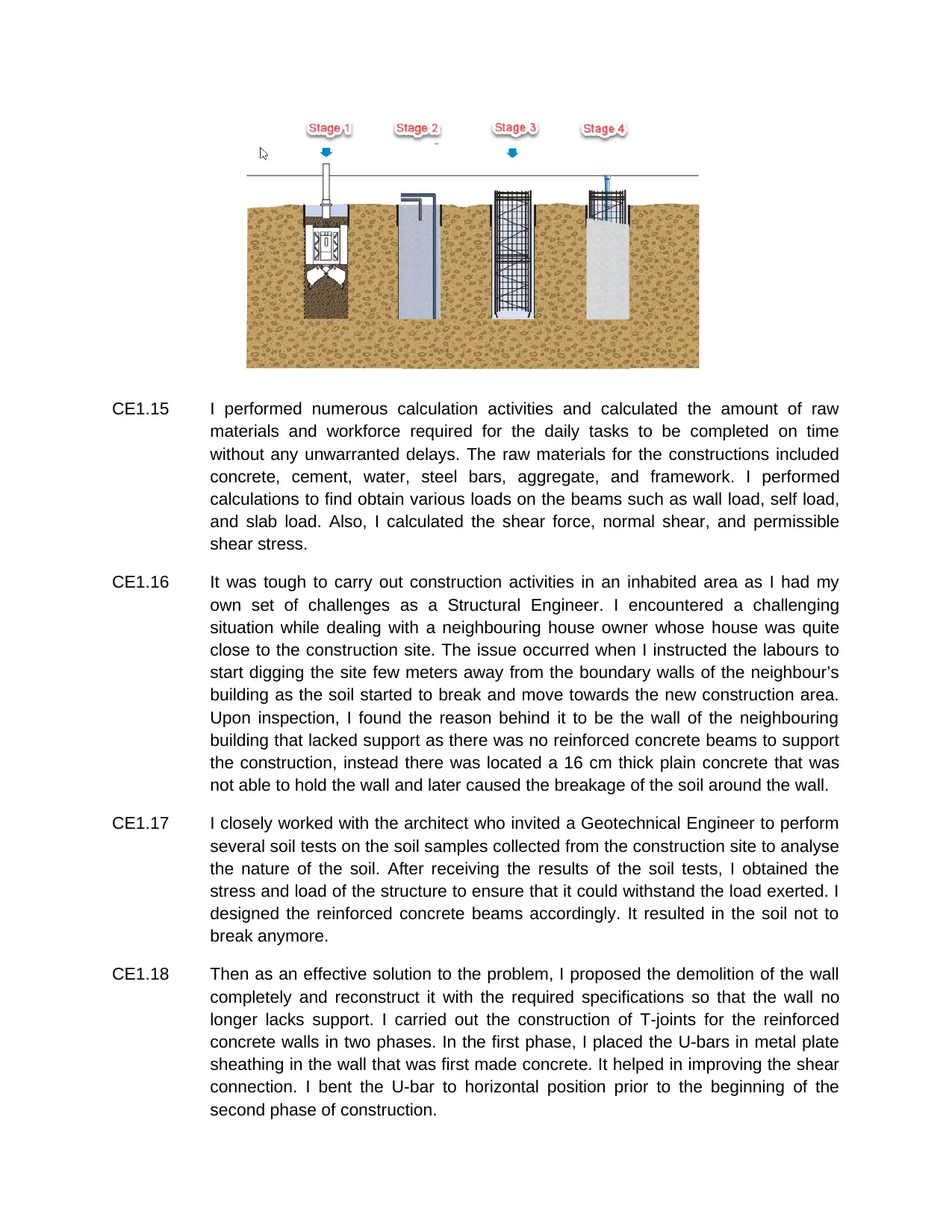
CE1.15 I performed numerous calculation activities and calculated the amount of raw
materials and workforce required for the daily tasks to be completed on time
without any unwarranted delays. The raw materials for the constructions included
concrete, cement, water, steel bars, aggregate, and framework. I performed
calculations to find obtain various loads on the beams such as wall load, self load,
and slab load. Also, I calculated the shear force, normal shear, and permissible
shear stress.
CE1.16 It was tough to carry out construction activities in an inhabited area as I had my
own set of challenges as a Structural Engineer. I encountered a challenging
situation while dealing with a neighbouring house owner whose house was quite
close to the construction site. The issue occurred when I instructed the labours to
start digging the site few meters away from the boundary walls of the neighbour’s
building as the soil started to break and move towards the new construction area.
Upon inspection, I found the reason behind it to be the wall of the neighbouring
building that lacked support as there was no reinforced concrete beams to support
the construction, instead there was located a 16 cm thick plain concrete that was
not able to hold the wall and later caused the breakage of the soil around the wall.
CE1.17 I closely worked with the architect who invited a Geotechnical Engineer to perform
several soil tests on the soil samples collected from the construction site to analyse
the nature of the soil. After receiving the results of the soil tests, I obtained the
stress and load of the structure to ensure that it could withstand the load exerted. I
designed the reinforced concrete beams accordingly. It resulted in the soil not to
break anymore.
CE1.18 Then as an effective solution to the problem, I proposed the demolition of the wall
completely and reconstruct it with the required specifications so that the wall no
longer lacks support. I carried out the construction of T-joints for the reinforced
concrete walls in two phases. In the first phase, I placed the U-bars in metal plate
sheathing in the wall that was first made concrete. It helped in improving the shear
connection. I bent the U-bar to horizontal position prior to the beginning of the
second phase of construction.
materials and workforce required for the daily tasks to be completed on time
without any unwarranted delays. The raw materials for the constructions included
concrete, cement, water, steel bars, aggregate, and framework. I performed
calculations to find obtain various loads on the beams such as wall load, self load,
and slab load. Also, I calculated the shear force, normal shear, and permissible
shear stress.
CE1.16 It was tough to carry out construction activities in an inhabited area as I had my
own set of challenges as a Structural Engineer. I encountered a challenging
situation while dealing with a neighbouring house owner whose house was quite
close to the construction site. The issue occurred when I instructed the labours to
start digging the site few meters away from the boundary walls of the neighbour’s
building as the soil started to break and move towards the new construction area.
Upon inspection, I found the reason behind it to be the wall of the neighbouring
building that lacked support as there was no reinforced concrete beams to support
the construction, instead there was located a 16 cm thick plain concrete that was
not able to hold the wall and later caused the breakage of the soil around the wall.
CE1.17 I closely worked with the architect who invited a Geotechnical Engineer to perform
several soil tests on the soil samples collected from the construction site to analyse
the nature of the soil. After receiving the results of the soil tests, I obtained the
stress and load of the structure to ensure that it could withstand the load exerted. I
designed the reinforced concrete beams accordingly. It resulted in the soil not to
break anymore.
CE1.18 Then as an effective solution to the problem, I proposed the demolition of the wall
completely and reconstruct it with the required specifications so that the wall no
longer lacks support. I carried out the construction of T-joints for the reinforced
concrete walls in two phases. In the first phase, I placed the U-bars in metal plate
sheathing in the wall that was first made concrete. It helped in improving the shear
connection. I bent the U-bar to horizontal position prior to the beginning of the
second phase of construction.

CE1.19 Then I constructed the horizontal section of corner and T-joints of monolithic
reinforced concrete walls. I performed the detailing of the interconnecting bars
correctly as the bars could not be bent at the internal corner as when they are
subjected to tension, they would split the concrete.
CE1.20 I communicated with the stakeholders to decide the priority of the engineering
activities to be carried out in the project for the timely completion of the project
tasks. I took care of the communications with the vendors and the suppliers for
delivery of the materials required for the project activities. I reviewed and took care
of the renewal of the contracts of the subcontractors working in the project. I
periodically had a check on the quality of the construction work. Though I was not
completely responsible for the scoping and budgeting, I regularly provided my
inputs that could save cost.
CE1.21 I worked in collaboration with my team members, cross-functional teams and
managers. I sought inputs from the whole team in the challenging situations and
reinforced concrete walls. I performed the detailing of the interconnecting bars
correctly as the bars could not be bent at the internal corner as when they are
subjected to tension, they would split the concrete.
CE1.20 I communicated with the stakeholders to decide the priority of the engineering
activities to be carried out in the project for the timely completion of the project
tasks. I took care of the communications with the vendors and the suppliers for
delivery of the materials required for the project activities. I reviewed and took care
of the renewal of the contracts of the subcontractors working in the project. I
periodically had a check on the quality of the construction work. Though I was not
completely responsible for the scoping and budgeting, I regularly provided my
inputs that could save cost.
CE1.21 I worked in collaboration with my team members, cross-functional teams and
managers. I sought inputs from the whole team in the challenging situations and
Paraphrase This Document
Need a fresh take? Get an instant paraphrase of this document with our AI Paraphraser
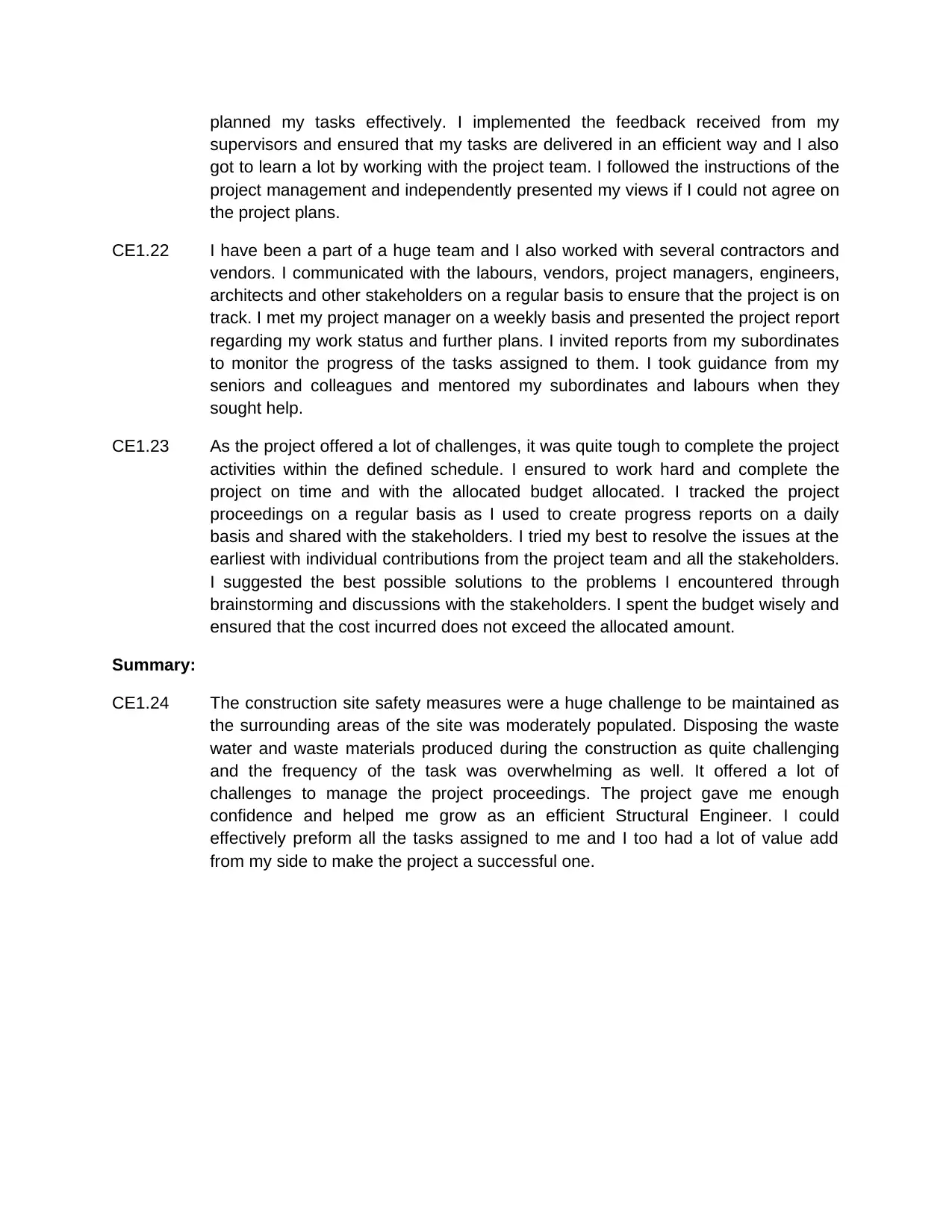
planned my tasks effectively. I implemented the feedback received from my
supervisors and ensured that my tasks are delivered in an efficient way and I also
got to learn a lot by working with the project team. I followed the instructions of the
project management and independently presented my views if I could not agree on
the project plans.
CE1.22 I have been a part of a huge team and I also worked with several contractors and
vendors. I communicated with the labours, vendors, project managers, engineers,
architects and other stakeholders on a regular basis to ensure that the project is on
track. I met my project manager on a weekly basis and presented the project report
regarding my work status and further plans. I invited reports from my subordinates
to monitor the progress of the tasks assigned to them. I took guidance from my
seniors and colleagues and mentored my subordinates and labours when they
sought help.
CE1.23 As the project offered a lot of challenges, it was quite tough to complete the project
activities within the defined schedule. I ensured to work hard and complete the
project on time and with the allocated budget allocated. I tracked the project
proceedings on a regular basis as I used to create progress reports on a daily
basis and shared with the stakeholders. I tried my best to resolve the issues at the
earliest with individual contributions from the project team and all the stakeholders.
I suggested the best possible solutions to the problems I encountered through
brainstorming and discussions with the stakeholders. I spent the budget wisely and
ensured that the cost incurred does not exceed the allocated amount.
Summary:
CE1.24 The construction site safety measures were a huge challenge to be maintained as
the surrounding areas of the site was moderately populated. Disposing the waste
water and waste materials produced during the construction as quite challenging
and the frequency of the task was overwhelming as well. It offered a lot of
challenges to manage the project proceedings. The project gave me enough
confidence and helped me grow as an efficient Structural Engineer. I could
effectively preform all the tasks assigned to me and I too had a lot of value add
from my side to make the project a successful one.
supervisors and ensured that my tasks are delivered in an efficient way and I also
got to learn a lot by working with the project team. I followed the instructions of the
project management and independently presented my views if I could not agree on
the project plans.
CE1.22 I have been a part of a huge team and I also worked with several contractors and
vendors. I communicated with the labours, vendors, project managers, engineers,
architects and other stakeholders on a regular basis to ensure that the project is on
track. I met my project manager on a weekly basis and presented the project report
regarding my work status and further plans. I invited reports from my subordinates
to monitor the progress of the tasks assigned to them. I took guidance from my
seniors and colleagues and mentored my subordinates and labours when they
sought help.
CE1.23 As the project offered a lot of challenges, it was quite tough to complete the project
activities within the defined schedule. I ensured to work hard and complete the
project on time and with the allocated budget allocated. I tracked the project
proceedings on a regular basis as I used to create progress reports on a daily
basis and shared with the stakeholders. I tried my best to resolve the issues at the
earliest with individual contributions from the project team and all the stakeholders.
I suggested the best possible solutions to the problems I encountered through
brainstorming and discussions with the stakeholders. I spent the budget wisely and
ensured that the cost incurred does not exceed the allocated amount.
Summary:
CE1.24 The construction site safety measures were a huge challenge to be maintained as
the surrounding areas of the site was moderately populated. Disposing the waste
water and waste materials produced during the construction as quite challenging
and the frequency of the task was overwhelming as well. It offered a lot of
challenges to manage the project proceedings. The project gave me enough
confidence and helped me grow as an efficient Structural Engineer. I could
effectively preform all the tasks assigned to me and I too had a lot of value add
from my side to make the project a successful one.
1 out of 8
Related Documents
Your All-in-One AI-Powered Toolkit for Academic Success.
+13062052269
info@desklib.com
Available 24*7 on WhatsApp / Email
![[object Object]](/_next/static/media/star-bottom.7253800d.svg)
Unlock your academic potential
© 2024 | Zucol Services PVT LTD | All rights reserved.





